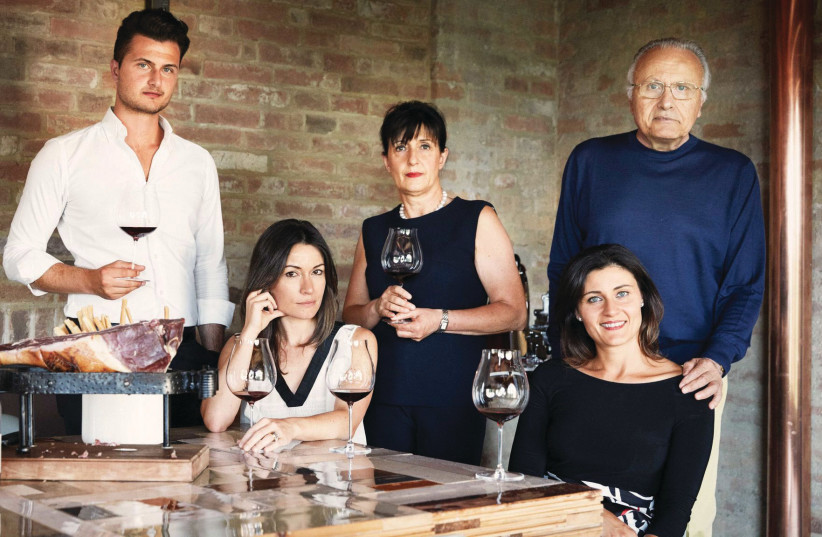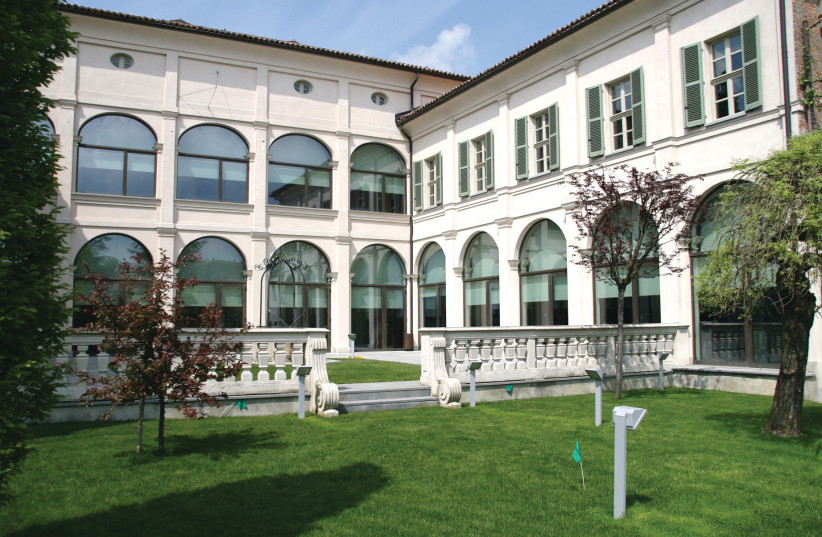I found myself on Montefiore Road heading toward Tel Aviv’s Montefiore Hotel. You would think I was going there to taste a Montefiore wine, but no, the offer was far better than that. I was on my way to meet Giovanni Gaja and to taste Gaja wines. Gaja wines for lunch? No complaints there. Gaja is one of those few iconic names where one name is sufficient.
Angelo Gaja, Giovanni’s father, is in the Pantheon of wine gods, bringing Piedmont, and particularly Barbaresco, into the modern world of winemaking. Along with Antinori of Tuscany, Gaja personified the new quality of Italian wine, and he is arguably Italy’s most well-known wine personality. His dynamism, creativity, innovation, pursuit of excellence and courage led the crest of the wave of the Italian quality revolution.
Gaja the winery is situated in the charming, unpretentious village of Barbaresco in Piedmont (at the foot of the mountain) in northwest Italy. Google Gaja and you will find all the information you need about the person, the winery or the wine. Alternatively, you can read The Vines of San Lorenzo or the paperback The Making of Great Wine, by Edward Steinberg. This is one of my favorite wine books. It tells the Gaja story and gives an insight into wine growing and winemaking at the highest level.
Very astutely, they founded a local distribution company featuring the finest from each country, run in parallel to their winery. Angelo took care of the winery and vineyards, and his wife, Lucia, looked after the distribution business. Then, they represented Romanee Conti from France, Mondavi from California, Penfolds from Australia and Riedel glasses.
 THE GREAT Angelo Gaja with his family. They run their wineries and their distribution business in Italy. (credit: Gaja)
THE GREAT Angelo Gaja with his family. They run their wineries and their distribution business in Italy. (credit: Gaja)In the 1990s, I was working for the Golan Heights Winery and figured that Yarden wines were the best in the eastern Mediterranean. Maybe they would be interested. Therefore, 25 years ago, when Giovanni was but five years old, I visited chez Gaja to close a deal whereby the Golan Heights Winery would be represented by Gaja Distribution in Italy. It was important because it was recognition outside the kosher bubble. They eventually took three Yarden wines, and it was the best compliment. Now they sell many more Golan wines, and the relationship still remains strong after all these years.
In the days of courtship and early business, I used to meet Angelo Gaja at wine exhibitions. I would arrive at the Gaja stand slightly apprehensive and a little excited. You were about to meet a legend. Then you would be ushered into an inner, inner room. Then a curtain would be swept aside, and you would see the great man sitting at a desk, ready for an audience of few minutes. It was not unlike being ushered in to meet the Pope, or waiting to kiss the Godfather’s hand.
He was always kind, respectful and attentive, but there was a smoldering impatience. You always had the feeling his mind was on the meeting after next. He was always dressed with style; he is Italian, after all. Once we met in a corridor. I remarked on his nice suede jacket and moved to touch it. He recoiled slightly and swatted me away. He did not want my grubby fingerprints to soil his immaculate jacket.
GRADUALLY, THE next generation has become more and more involved, such as the eldest daughter, Gaia, whom I briefly met at Vinexpo Exhibitions in Bordeaux. Now I stand before his son. He has the broad forehead of his father and some of that Italian style. Dark suit, white shirt embossed with his initials, white handkerchief stuffed into his breast pocket, soft moccasin shoes, without socks. He had something of that Gaja confidence, with passion, pride shining through, toned down with a self-deprecating humor, too.
He explains he represents the fifth generation of the family, which founded their winery in 1859. He tells us his father is now 82 but still behaves like he is 16. He is still the first to arrive at the winery and the last to leave at the end of a long day.
One of the slogans drilled into the family at an early age is “Think different. If you think like the others, you will be like the others.” He told us that the revolution in winemaking took place in the 1980s, but in the last 30 years the main developments have been in the vineyards. He talked a great deal about climate change. We were shocked when he told us that the 2017 vintage had 96 days of drought.
Giovanni was very generous about the wines of the Golan Heights Winery, saying, “The wines are excellent and represent something different.” The day after our meeting, he traveled to the winery in Katzrin, while his Jewish girlfriend enjoyed Tel Aviv.
When I first knew the Gajas, they had one winery. Now they have five. Their focus over the years has been the little village of Barbaresco, the fickle but unique Nebbiolo grape variety and Barbaresco and Barolo wines.
These days they are heavily involved in the four B’s of Italian wines: Not just Barbaresco and Barolo, but also Brunello and Bolgheri. In 1994, they bought a historic winery called Pieve di Santa Restituta in the charming hill town, Montalcino, in the Siena district of Tuscany. Here they produce the iconic Brunello di Montalcino, focusing on the Sangiovese grape variety.
In 1996 they purchased land in Bolgheri, on the Tuscan coast south of Livorno, and built a stylish new winery called Ca’ Marcanda. This means “the house of endless negotiations,” reflecting the frustration of the endless talks that took place before the deal was finalized. It is in the region of the great wines known as Super Tuscans. Here, it is Bordeaux varieties that are planted, in particular Merlot, Cabernet Sauvignon and Cabernet Franc.
I visited the winery in 2005 when driving up the coast to see the birthplace of Moses Montefiore in Livorno. It was understated and incredibly impressive. In 2017, the Gajas dipped their toes into Sicily, founding a joint venture with Alberto Graci on Mount Etna. Here, they focus on indigenous varieties. Now they have returned to base in Piedmont, with a new project in the Alta Langhe, at a higher altitude, where they will be focusing on white wines.
 CASTELLO GAJA in Barbaresco, Piedmont, in northwest Italy. (credit: Gaja)
CASTELLO GAJA in Barbaresco, Piedmont, in northwest Italy. (credit: Gaja)
Gaja wines are imported to Israel by Shaked, a family of importers, distributors, retailers and producers. They have a finger in every pie. They are owners of the Derech Ha’Yayin (Wine Route) wine store chain and partners in Recanati Winery. They first brought Gaja to Israel in 2000, and it was then a statement of their status as wine importers.
We sat down to enjoy the food of the Montefiore Hotel as the wines were poured. This is considered one of Israel’s leading restaurants. Poor Giovanni did not have time to eat, as he spent most of the time telling the family story and talking us through the wines. We did not taste the entire range but enjoyed sampling the following wines:
Ca’ Marcanda Vistamere Bolgheri 2020
This is a blend of Vermentino, Viognier and Fiano. The Vermentino provides the acidity and freshness, the Viognier – aromatics and body, and the Fiano – fruit. The wine is fresh and floral on the nose; broad, complex and ripe on the palate, with a flavorful finish. NIS 230.
Idda Blanco Etna 2021
This is the white from the Sicilian joint venture, on the southwest slopes of Mount Etna at 30 to 820 m. above sea level. The volcanic soil is apparently black. The word “Idda” is a local name of Mount Etna, which emphasizes female characteristics. Made from the local variety Carricante, it is fragrant, minerally and refreshing, with a great purity of fruit. NIS 240.
Idda Rosso Etna 2019
It is made from the local Nerello Mascalese grapes that primarily grow on Mount Etna. The wine is rough in a nice way, with a cherry berry aroma, a minerally acidity mingling with tannins and a focused finish. Slightly edgy and very refreshing. I loved it. NIS 240.
Ca’ Marcanda Magari Bolgheri 2018
Each of their three reds are blends but are based predominately on a different variety. The prestige Ca’ Marcanda is based on Cabernet Sauvignon; the third label, Promis, is based on Merlot. The Magari is mainly based on Cabernet Franc, balanced with Cabernet Sauvignon and Petit Verdot. It is quite plush and expressive.
Full of blackberry fruit, with green herbaceous and herbal notes, a very solid structure and a long, fruit-driven finish. All the names of Gaja wines have deep meanings and humor. The word magari means something between yes and no, or “a definite maybe.” If someone chasing their beau was given the answer magari, they would not give up hope. NIS 300.
Gaja Dagromis Barolo 2017
The pheasants featured on the label appear on the labels of a few wines. This is because of their prominence in the woods surrounding the vineyards. The wine is named Dagromis (from Gromis), after the person from whom they purchased the vineyard. The wine had great grip, a savory nose of rose petals and cherries, with good acidity and soft tannins. An introductory Gaja wine to Barolo, but a magnificent wine nonetheless. NIS 430.
Gaja Barbaresco 2017
This has the label that has accompanied Gaja’s greatness. A simple black and white label: the word “Gaja” written large; everything else written small. It is the signature wine that has accompanied the family since the winery was founded 160 years ago.
It has a beautifully haunting aroma of cherry and strawberry with floral notes and a touch of spice. The wine is refined yet has a steely texture, is powerful, yet elegant, and wonderfully fresh. It is not an exaggeration to call this a truly great wine. NIS 1,300.
 FROM LEFT: Ca’ Marcanda Magari, Gaja Dagromis, Gaja Barbaresco, Idda Red, Idda White, Ca’ Marcanda Vistamare. (credit: Gaja)
FROM LEFT: Ca’ Marcanda Magari, Gaja Dagromis, Gaja Barbaresco, Idda Red, Idda White, Ca’ Marcanda Vistamare. (credit: Gaja)Gaja has spent a lifetime honing an image of quality. No doubt, greatness and luxury do not come cheap, but his wines are targets of connoisseurs, collectors and those with the resources to indulge. The name remains a symbol of the best in Italian wine.
The writer is a wine industry insider turned wine writer, who has advanced Israeli wines for 35 years. He is referred to as the English voice of Israeli wine. www.adammontefiore.com